Modern-day businesses are leaving no stone unturned to increase their efficiency and maximize profits. So, confronting digital transformation challenges and winning over them isn’t just a choice but a necessity for budding CEOs and CXOs.
Digital transformation is the buzzword of the tech town, but do we understand its implementation process and the significant changes it carries forward in the overall experiences?
With the evolution in technology, businesses ought to transform themselves into digital enterprises, no matter how small or big. At this point, it’s not about companies “choosing” to transform, instead it is about “how” to carry forward the transformation.
Though most decision-makers of the 21st-century recognize the need for digital transformation to improve their business processes, many equate the process of doing so with the chaotic deployment of complex technologies.
Moreover, according to McKinsey, just 16% of executives from different companies claim that their digital transformation efforts are succeeding. So, where are 86% of businesses lacking?
Why is Digital Transformation Difficult?

Successful Digital Transformation requires not only the right set of tools but the right expertise & guidance to drive the process for the best results.
Businesses not accepting/responding according to the needs of digital transformation fail miserably. Organizations find it challenging to match the pace of digital transformation, especially for the ones sticking to traditional operational methods.
While the ones fiercely adopting digital transformation stay longer in the game and are recognized as leaders.
However, the more simple it sounds, the more challenging the execution is.
- More than 50% of digital transformation efforts fizzled completely in 2018. (Forrester)
- 70% of digital transformations fail, most often due to resistance from employees. (McKinsey)
- Only 16% of employees said their company’s digital transformations have improved performance and are sustainable in the long term. (McKinsey)
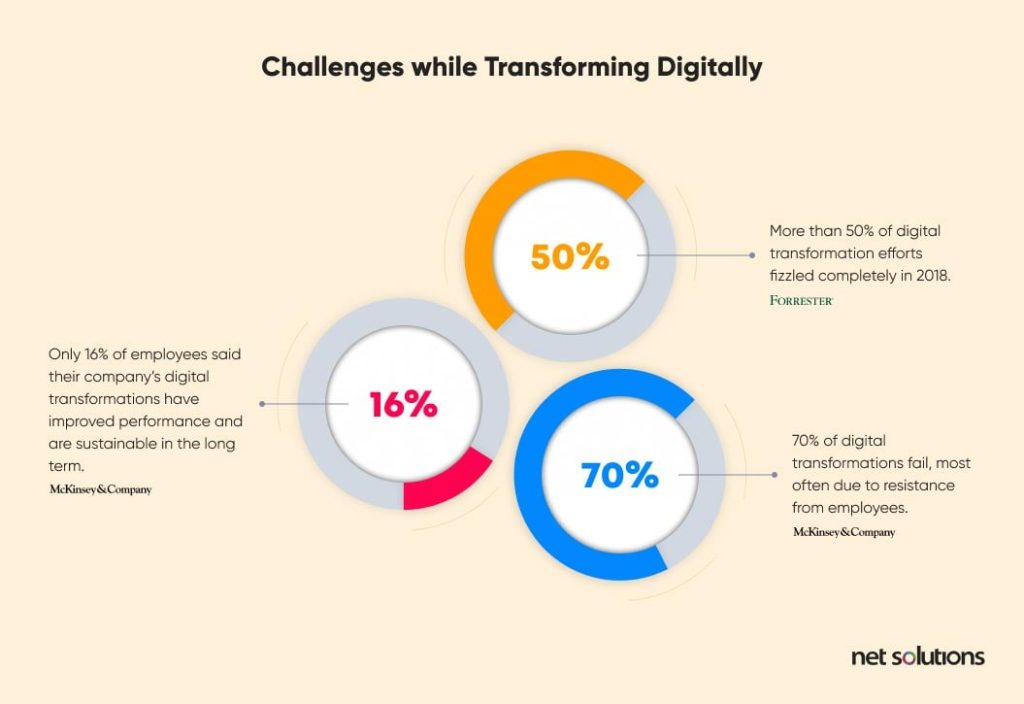
This leads us to the question, why is digital transformation so challenging?
With more Agile-oriented companies entering into the picture, these new-age digital companies have transformed human life. The leaders in the market are implementing new technologies while ensuring faster time to market. The way of transporting, communicating, shopping, everything has taken a significant shift.
These new companies have the natural ability to quickly adapt to changing market conditions and become dominant players in the industries.
This signifies a competition more robust than ever, with traditional companies rushing to adapt themselves digitally. The change of business environment puts pressure on the overall functioning of traditional companies, be it with organizational structure, customers, stakeholders.
Trying to handle these multiple expectations without proper planning, overall co-operation, and lack of flexibility leads businesses to fumble on the ground.
It isn’t easy to maintain the equilibrium between digital challenges and to put the right amount of focus to handle current business processes, stakeholders, and customers.
Companies specialized in genres apart from IT may find it challenging to learn the best digital transformation technology that suits their business and functional requirements.
It is more than essential to select and leverage the right digital transformation consultancy agency that understands and performs in the company’s best interest.
Top 5 Digital Transformation Challenges Impacting Businesses
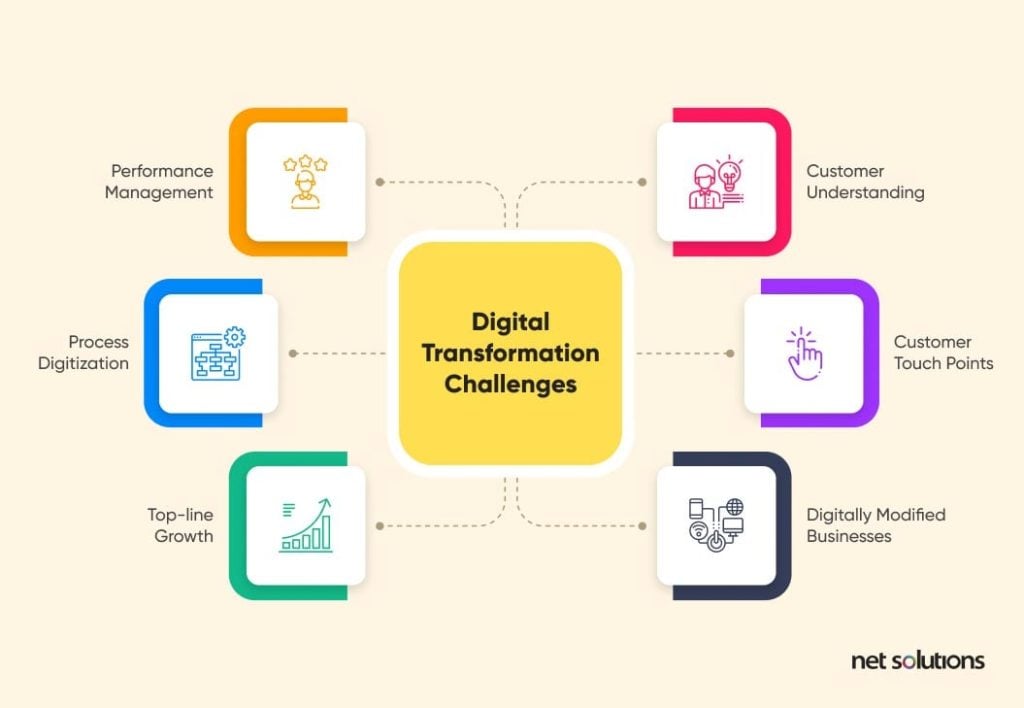
The sure-shot way to meet success in your organization’s digital transformation journey lies in thoroughly understanding and preparing for the digital transformation challenges that come en-route.
The transformation impacts not just businesses and their employees but also the stakeholders associated with the brand. Transforming any business digitally should be executed with extreme care and diligence.
We shall understand what’s not letting these businesses succeed in this must-take route to grow and scale and what’s the solution to kick it off like a pro.
So, let’s understand the five key challenges to digital transformation and find their solutions:
1. Organizational Culture

Shortcomings in the organization’s culture are one of the biggest business transformation challenges. The most common misconception that business owners have is that digital transformation is possible if a company upgrades its tools and technologies.
However, the reality is that digital transformation is not just about technologies. It is also about your organization’s ability to adapt to these changes. Even if you develop a robust digital transformation strategy, governing organization-wide change can be one of the most prominent digital transformation problems.
Failing to communicate the importance of digital transformation across the enterprise might lead to resistance amongst the employees to change. Employees usually resist any change until they are made aware of the real impact that the change will bring in their work-life.
Solution
Company culture and good communication is the key to tackle digitization challenges. Therefore, it is essential to encourage employees and other stakeholders to get accustomed to the digital culture, tools, technology, and solutions. It will help your business to persuade the workforce during the transformation phase.
To stay in line with the digital transformation initiatives you take, every employee of your organization should be agile and adaptable. To find whether your company has a digital culture or not, analyze how your employees talk and what’s their mindset:
| Before Digital Transformation | After Digital Transformation |
|---|---|
| We believe in research. We never interact with our customers. | Customers are at the heart of what we do. We understand them better. |
| We don’t communicate with each other much. | We rely on brainstorming and cross-team communication to make sure everyone is on the same page. |
| We follow research papers. | We make real-time decisions based on customer’s feedback. |
| We know what is best. | Our customers tell us what they want. |
Also, be involved in the ‘Active Communication’ of the vision: why the digital transformation is necessary and how it will affect the organization. You must integrate your digital strategy into the business strategy. One of the key challenges of digital transformation is that its process needs the whole organization to be involved in making it work. Thus, approach this program as a product and brand it.
2. Lack of IT Resources and Management
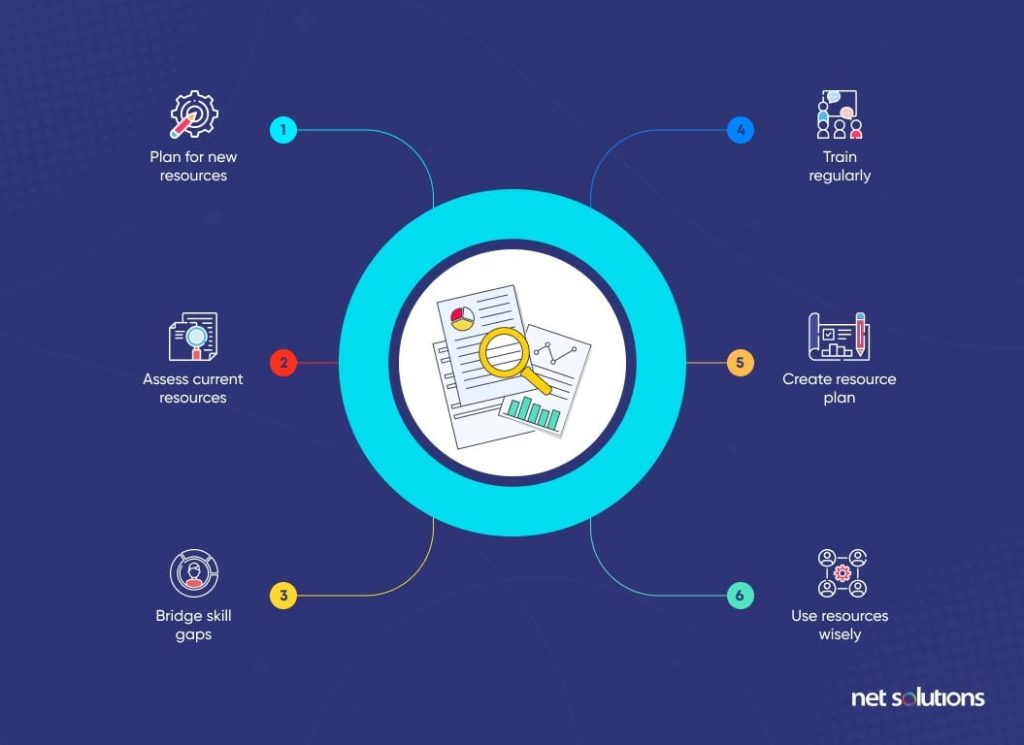
Poor resource management planning and lack of IT resources are some of the critical challenges related to digital transformation. In terms of IT resources, lack of workforce and talent war are two aspects that act as a hurdle to a successful digital transformation.
77% of companies consider missing digital skills as the key hurdle to their digital transformation. Capgemini
There is an apparent shortage of digital workforce, and without them, you can never succeed in overcoming digital transformation challenges. Thus, it is essential to take this challenge seriously and get rid of it prior to embarking upon a digital transformation journey.
Solution
Successful digital transformation requires a careful approach and having an inefficient team, and a weak strategic plan can make the job difficult during the transition phase. Thus, invest in digital talent and build a pool of talent with strong prowess in technology and solutions.
Make sure your HR department is equipped and skilled to bring innovative solutions to bridge the digital skills gap. But, do not rely on HRs only to bring the talent in your team. Here is how you can do the needful on your own:
a) Assess current resources:
Take a look at your team and see the tasks assigned to every member.
Find ways to automate these tasks if you can.
Avoid micro-management and delegate tasks as per the expertise and skills available.
b) Outsource to bridge skill gaps:
If you want to overcome all digital transformation challenges, you will have to skip the boundaries. Look for the talent outside and find what you need. Outsourcing is a highly utilized, economical, and efficient approach to bridge the skill gap.
c) Use tools like CRM:
To tackle digitization challenges, you will have to find tools that reduce the time taken in back-office and administrative tasks. For example, you can use CRM to centralize the data you and your team require.
Thus, have a clear plan for the resources available and the need for further digital talent to take the digital transformation forward.
3. Lack of Clarity on the Digital Transformation Budget

A capital plan for the digital transformation process is one of the biggest hurdles that could hamper the entire project. Setting up a limited budget for building successful digital transformation processes can be bewildering for most business heads.
To drive digital transformation, an organization needs to make an investment in acquiring the right technology and the right digital experience team to execute it. European insurer Axa, for example, invested €950 million over just two years.
Thus, the whole process requires a good amount of capital, which may initially lead to lower profits, but in the long run, this investment will become one of the primary reasons for your business’s success.
This lack of clarity on budget affects the decision-making and forces the leaders to step back when it comes to digital transformation funding.
Solution
Have a strategy in place for the long-term with a budget in mind. Organizations that are firm on their foundation and have a good capital plan on their table are ready to embark upon their digital transformation journey.
Remember, budgeting in digital transformation requires careful planning as any element missed out can result in a budget crisis or colossal loss later on.
Here are a few tips for you to achieve digital transformation on your budget effectively:
- Involve more and more departments or their representatives and follow a collaborative approach while planning on the budget.
- Try setting a flexible budgeting model. Many digital transformation challenges may come your way, and you need to accommodate all. So a fixed budget won’t help.
- It is essential to train your staff for a successful digital transformation of your company. So, consider allocating a separate budget for training programs.
Raising a company’s Digital Quotient, or DQ requires the targeted allocation of capital and operating expenditures. McKinsey & Company
One of the key components of a good capital plan includes the CEO’s allocation process in the digital transformation journey and the tempo at which it should operate.
While we walk through the importance of budget in Digital Transformation, it holds immense value to understand what leaders in the industry have to say about the Return on Investment of Digital Transformation challenges.
ROI in digital transformation
Prioritizing digital transformation – moving from analog to paperless technologies – is essential for leaders to meet organizational goals, whether that involves automating manual processes or using digital tools to collaborate and work more seamlessly.
A key aspect for evaluating the success of an enterprise’s digital transformation is by determining the ROI of a digital transformation.
Companies that have successful digital transformation initiatives can expect to see a 17% return on investment (ROI) over the next year, according to an Avanade report.
96% of its respondents say they have a digital transformation strategy, but close to half say their organization is becoming fatigued with the transformation efforts according to Avanade.
In a recent report by Gartner, 66% of business leaders said they have plans for a digital business transformation, only 11% of the leaders admitted to achieving the transformation at scale.
Learn how CRMs improve CX and 7 best CRM platforms
Read More4. Digital Security
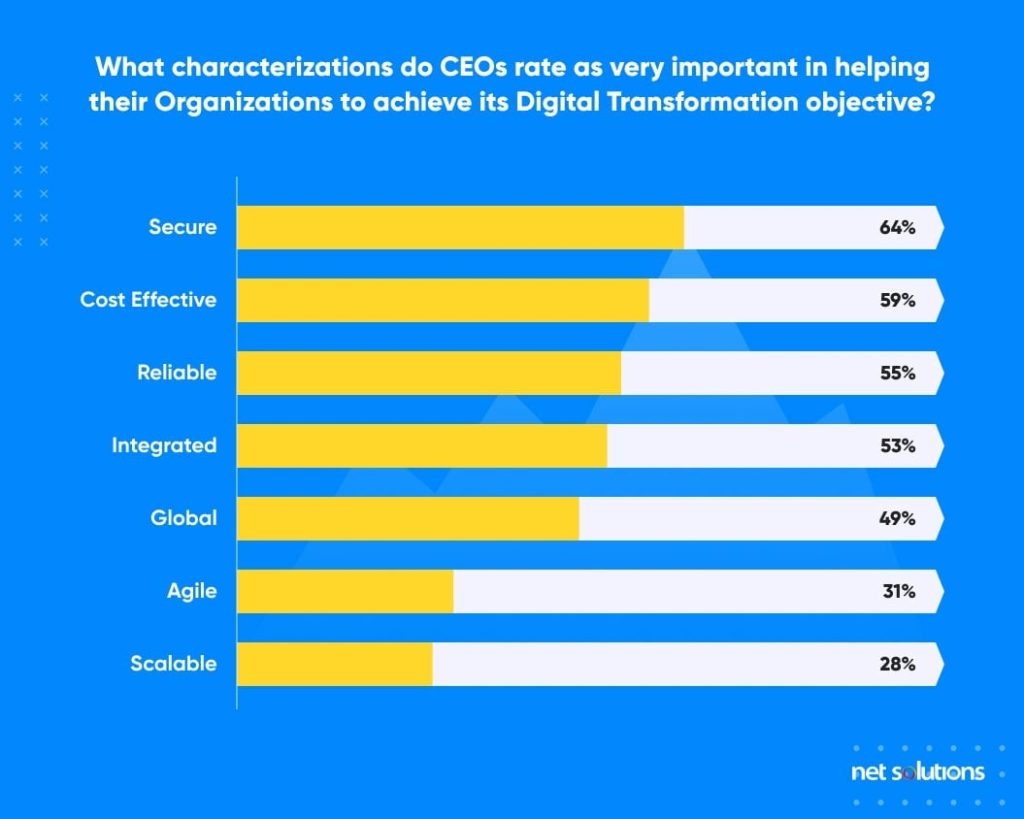
Data security is a concern for most visionaries as cybersecurity is complex, dynamic, and fast-changing. The latest reports from industry research experts like Forrester and Gartner are pointing towards the same concerns.
Net Solutions’ digital transformation report for 2020 states that a company’s successful digital transformation journey relies on its ability to secure its digital operations.
Thus, successful integration of digital technologies requires a transformation of security, which is a top-most challenge faced by many organizations embarking on a digital transformation journey.
55% of companies said that security was the number-one challenge they face when implementing digital enablement technologies. SoftServe
Solution
Follow a security-first approach. Security testing must be embedded into all applications as the first line of defense. Start to deploy security controls across many different internal, public, and cloud environments. A good ‘organization security’ strategy as mentioned in one of our previous blogs, should include the following features:
The organization’s employees are getting the tools more connected, engaged, and mobile.
Nonstop connectivity, rich collaboration to support deeper engagement, and security everywhere.
Deploying an end-to-end, policy-driven security approach to better secure every aspect of our value chain.
Even CEOs rate security as the top-most characteristic that enables the organization to become a digitally transformed organization.
CXOs should spread security responsibility to different departments by shifting from the DevOps model to the DevSecOps model to tackle the security challenge. This step would enable businesses to turn security into an enable of digital transformation rather than a hurdle.
Learn how to navigate compliance and security in today's digital landscape
Read More5. The Agility Challenge
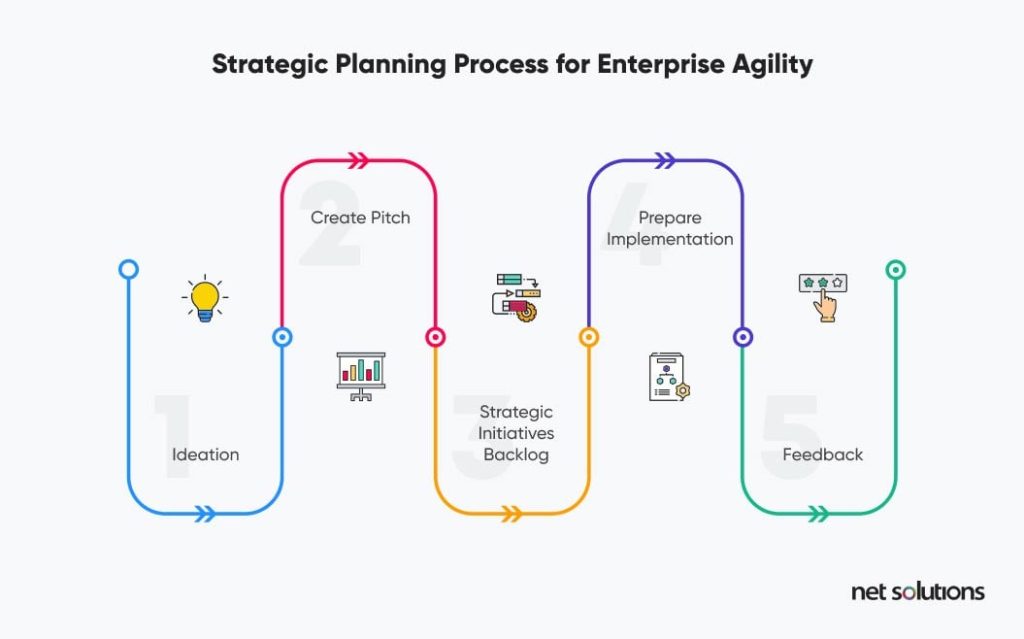
Agile Transformation is the heart of digitization and scaling is important for any successful digital transformation in large enterprises. Even a study reveals that 68% of companies identified agility as one of their most important initiatives for a successful digital transformation.
However, becoming agile before embarking upon a successful digital transformation journey is a challenge, and many organizations fail in their agile transformation process.
Solution
The parameters that play an indispensable role in laying the foundation for scaling agile capabilities and approach at the enterprise level include — SAFe (Scaled Agile Framework) agile, flexible architecture, and efficient release management.
a) Flexible Architecture is aligned to create releases. Micro-services and open APIs create a flexible, extensible architecture that can manage diverse technologies while reducing costs at the same time.
b) Agile Teams (both onshore and offshore) are utilized to support these efforts. By establishing offshore-capable development and test environments, firms can leverage different time zones to accelerate development cycles.
c) A dedicated release management function facilitates ongoing management, verification, and communication about the scope of releases in multiple iterations. Application release automation tools should be applied to support continuous delivery.
Conclusion
Digital transformation challenges are complex to handle. Therefore, organizations need to create a substantial ecosystem to drive change seamlessly. Before embarking upon a digital transformation journey, build a strategy to eliminate the roadblocks to DX, thereby ensuring successful digitization.
Note, investing in emerging digital technologies won’t equate to complete successful digital transformation. People, processes, and technology move hand-in-hand to form the foundational elements while strategizing DX efforts. Make informed technology investments, as it will help deliver real value both to the organization and your customers.




